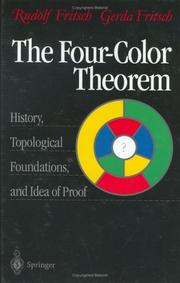| Listing 1 - 9 of 9 |
Sort by
|
Book
Year: 1978 Publisher: Konstanz Universitäts-Druckerei
Abstract | Keywords | Export | Availability | Bookmark
 Loading...
Loading...Choose an application
- Reference Manager
- EndNote
- RefWorks (Direct export to RefWorks)

ISBN: 0387984976 1461272548 1461217202 Year: 1998 Publisher: New York, N.Y. Springer
Abstract | Keywords | Export | Availability | Bookmark
 Loading...
Loading...Choose an application
- Reference Manager
- EndNote
- RefWorks (Direct export to RefWorks)
During the university reform of the 1970s, the classical Faculty of Science of the venerable Ludwig-Maximilians-Universitat in Munich was divided into five smaller faculties. One was for mathematics, the others for physics, chemistry and pharmaceutics, biology, and the earth sciences. Nevertheless, in order to maintain an exchange of ideas between the various disciplines and so as not to permit the complete undermining of the original notion of "universitas,,,l the Carl-Friedrich-von-Siemens Foundation periodically invites the pro fessors from the former Faculty of Science to a luncheon gathering. These are working luncheons during which recent developments in the various disciplines are presented by means of short talks. The motivation for such talks does not come, in the majority of cases, from the respective subject itself, but from another discipline that is loosely affiliated with it. In this way, the controversy over the modern methods used in the proof of the Four-Color Theorem had also spread to disciplines outside of mathematics. I, as a trained algebraic topologist, was asked to comment on this. Naturally, I was acquainted with the Four-Color 1 A Latin word meaning the whole of something, a collective entirety. Vll viii Preface Problem but, up to that point, had never intensively studied it. As an outsider,2 I dove into the material, not so much to achieve any scientific progress with it but to make this already achieved objective more understandable.
Discrete mathematics --- 519.1 --- Combinatorics. Graph theory --- Four-color problem. --- 519.1 Combinatorics. Graph theory --- Four-color problem --- Map-coloring problem --- Topology. --- Analysis situs --- Position analysis --- Rubber-sheet geometry --- Geometry --- Polyhedra --- Set theory --- Algebras, Linear
Book
Abstract | Keywords | Export | Availability | Bookmark
 Loading...
Loading...Choose an application
- Reference Manager
- EndNote
- RefWorks (Direct export to RefWorks)
Book
Abstract | Keywords | Export | Availability | Bookmark
 Loading...
Loading...Choose an application
- Reference Manager
- EndNote
- RefWorks (Direct export to RefWorks)

ISBN: 0521327849 9780521327848 9780511983948 9780521063876 Year: 1990 Publisher: Cambridge: Cambridge university press,
Abstract | Keywords | Export | Availability | Bookmark
 Loading...
Loading...Choose an application
- Reference Manager
- EndNote
- RefWorks (Direct export to RefWorks)
Book
Abstract | Keywords | Export | Availability | Bookmark
 Loading...
Loading...Choose an application
- Reference Manager
- EndNote
- RefWorks (Direct export to RefWorks)
Book
ISBN: 0511899262 0511983948 Year: 1990 Publisher: Cambridge : Cambridge University Press,
Abstract | Keywords | Export | Availability | Bookmark
 Loading...
Loading...Choose an application
- Reference Manager
- EndNote
- RefWorks (Direct export to RefWorks)
This book describes the construction and the properties of CW-complexes. These spaces are important because firstly they are the correct framework for homotopy theory, and secondly most spaces that arise in pure mathematics are of this type. The authors discuss the foundations and also developments, for example, the theory of finite CW-complexes, CW-complexes in relation to the theory of fibrations, and Milnor's work on spaces of the type of CW-complexes. They establish very clearly the relationship between CW-complexes and the theory of simplicial complexes, which is developed in great detail. Exercises are provided throughout the book; some are straightforward, others extend the text in a non-trivial way. For the latter; further reference is given for their solution. Each chapter ends with a section sketching the historical development. An appendix gives basic results from topology, homology and homotopy theory. These features will aid graduate students, who can use the work as a course text. As a contemporary reference work it will be essential reading for the more specialized workers in algebraic topology and homotopy theory.
CW complexes. --- Complexes. --- k-spaces.
Book

ISBN: 9783110886726 Year: 2011 Publisher: Berlin Boston
Abstract | Keywords | Export | Availability | Bookmark
 Loading...
Loading...Choose an application
- Reference Manager
- EndNote
- RefWorks (Direct export to RefWorks)
Digital

ISBN: 9783110886726 9783110144765 Year: 2011 Publisher: Berlin ;; Boston De Gruyter
Abstract | Keywords | Export | Availability | Bookmark
 Loading...
Loading...Choose an application
- Reference Manager
- EndNote
- RefWorks (Direct export to RefWorks)
| Listing 1 - 9 of 9 |
Sort by
|

 Search
Search Feedback
Feedback About UniCat
About UniCat  Help
Help News
News